Abstract
Carsharing companies can customize their service by adopting different pricing schemes and offers with the goal of increasing service attractivity, fleet usage and profits. Dynamic pricing strategies can be designed to adjust and balance cars’ availability temporally and spatially; they may pose some questions regarding customer equity, since such measures could impact their activities and mode choice. In this paper, we develop an experimental design for conducting an explorative analysis of how availability-based and time-based dynamic pricing schemes impact demand and supply performances. The strategy is simulated in the open-source agent-based software MATSim and compared to a fixed pricing policy scheme. Two spatial distributions of the value of time for the population of Berlin are applied (radially and coaxially) to systematically analyze agents’ behavior response to these pricing policies. Results confirm that when dynamic pricing is applied people with low value of time tend to abandon the carsharing mode in favor of other modes of transportation. Overall, the strategy applied in this study appears to be unfair, since it hinders low income groups from using the carsharing service.
1. Introduction
1.1. Literature Review
The idea behind carsharing services is straightforward: individuals can get access to a lease car without the burden of owning it, through membership of a carsharing program. Vehicles are available on demand for a short-term rental by paying a usage fee [1]. The widespread diffusion of mobile applications helped carsharing to become a mainstream service, since they are often used to book carsharing services on the fly, which allows for fast payment, provides users with a personalized experience, and implies a continuous supervision and usage data collection and analysis on the part of companies [2]. Offering flexible access to a car is arguably also one of the features which contributed the most to its success [3], allowing cars to be used up to 10% of the time over a day, which is considerably higher than the average for private cars [4]. A survey in the Netherlands showed that, among 363 carsharing users, 15% to 20% less kilometers were driven, resulting in 13% to 18% less CO2 emissions [5]. Carsharing has been demonstrated to help reduce greenhouse gas emissions—an average reduction of 0.58 t/year per household is observed in north America [6]. Furthermore, one carsharing vehicle has been shown to replace up to 13 privately owned vehicles, resulting in monthly household savings per US members of 154–435$ [7]. This evidence makes the effect of a paradigm shift toward shared mobility clear. Users tend to avoid the burden and the expense of ownership but benefit from the flexibility and the accessibility of a car. During the last two decades, carsharing attracted more and more attention in a variety of research fields, as witnessed by works on market analysis, pricing, location, travel behavior, and sustainability [8,9]. Given the private management nature of crsharing, some studies had a strong focus on efficiently managing the fleet while, at the same time, increasing companies’ profit [10,11]. The goal of this study is to assess the impact of two dynamic pricing policies on a round-trip carsharing program from both the members’ and the operational perspective. In fact, pricing policies on carsharing systems are still a fairly unexplored topic.
Concerning dynamic pricing strategies in one-way systems, a simulation study using Vienna’s taxi data proved that a dynamic incentive scheme is effective in equilibrating the fleet at the stations [12]. Furthermore, aiming at maximizing company profits, dynamic pricing was applied to a one-way system in a theoretical case study on the city of Lisbon. Results showed that pricing can be used to increase profit by achieving a more balanced system and hence reducing operational costs [13]. The influence of vehicle distribution on pricing computation was also addressed by the creation of a digitized decision support system. The support of an information system using dynamic pricing helped reduce the need for vehicle relocation, enhancing vehicle availability [14]. One-way free-floating carsharing has also been analyzed with different pricing strategies, e.g., in Ciari et al. [15]. The problem of how free-floating demand varies with different pricing strategies was applied to a case study on the metropolitan area of Zurich, Switzerland. Conclusions found the spatio-temporal profile of carsharing demand to be sensitive to pricing structures.
Even though carsharing is quite an established concept [16], models able to systematically assess its functionality have not been fully developed yet. Traditional trip-based models tend to use data that is too aggregated to allow researchers to grasp the peculiarity of a carsharing service. Dynamic traffic assignment approaches usually deal with a demand which is typically given as fixed-period OD matrices that cannot adapt to a dynamic pricing scheme [17]. The simulation of innovative transport modes with agent-based models has proven useful because of their microscopic nature and high temporal resolution. That is, regarding carsharing, the peculiarity of the services offered can be estimated in a realistic way and can capture car availability at a given location and at a given time. Among the various agent-based simulation platforms, MATSim (Multi-Agent Transport Simulation), while suitable for large-scale scenarios, is capable of providing a completely disaggregated representation of carsharing operations and utilization (i.e., single vehicle and single user definition [18]). Regarding pricing schemes, different pricing strategies were already tested in MATSim, particularly road tolls. A full daily plan for a population in the city of Zurich was simulated in order to test time-dependent tolls applied at the city center border. Multi-agent simulation was found to be more thorough in modeling the reaction of single travelers due to time-dependent tolls [17]. The ability of this type of simulator to identify the distribution of benefits at the system level in a road pricing context is illustrated in [19]. The study points out how the condition to identify said benefits introduces a non-linearity in the system in order not to cancel out gains and losses. In the context of cordon-pricing, MATSim is applied in order to assess the gains and losses of such policy [20]. Results show that this framework is a suitable decision-making tool for this kind of pricing scheme. In a study about the modeling of different pricing schemes [15] it is stated how establishing more solid patterns of consumer preferences can improve the ability of the simulator to deliver reliable system-level forecasts. Price policies regarding parking have been explored as well, showing that free-floating vehicles are able to use parking spaces more efficiently than private vehicles [21].
Most of these articles identify the calibration phase as undoubtedly important, given the granularity of the simulator. The property of this framework to be used in a wide variety of situations implies that several types of data need to be available in order to model all the characteristics that contribute to the agents’ behavior.
Studies related to dynamic pricing in carsharing have been conducted in order to maximize profit or vehicle utilization. Depending on the type of service, different strategies have been analyzed to improve the service. In the case of one-way station-based carsharing services, price variations based on the time of the day and pick-up zone help increase profits and balance carsharing vehicles’ stock [13]. Using reinforcement learning, a similar problem is addressed regarding the balance in the distribution of the fleet. A dynamic pricing scheme is found to be effective in flattening the uneven distribution of the vehicles among the stations [22]. Other forms of shared mobility have been the object of research on dynamic pricing schemes. A negative price strategy was introduced in dock-less bike sharing [23]. The study addresses a relocation problem using a user-based approach. The dynamic pricing proposed was found to be effective in attracting customers and balancing bike repositioning. Since two-way carsharing does not suffer relocation issues, given the intrinsic nature of the system, studies related to round-trip carsharing are more limited than their one-way counterparts. Dynamic pricing (or dynamic price discrimination) is extensively studied in the airline industry literature. It is defined as the adjustment of “prices based on the option value of future sales, which varies with time and units available” [24]. Considering the commonalities and differences between air and car sharing systems, it can be beneficial to carsharing operators to apply effective dynamic pricing strategies. For example, concerning dynamic pricing strategies in airline operations, it is noticeable how the goal of such scheme is to address incomplete markets rather than to make customers pay more [24]. Two main branches exist in airline pricing: intertemporal price discrimination (to buy a product for future consumption needs) and dynamic adjustment to stochastic demand (price in function of the selling rate of a product). In Williams [25] it is shown how these two complementing forces lead to significantly higher revenues if compared to more restrictive pricing strategies. Similar trends are found on the use of dynamic pricing strategies on hosting platforms such as Airbnb, where price changes in function of the day and the season [26]. Overall, carsharing differs greatly from these other services—for example, the amount of cars at one station cannot be compared to the amount of seats in a commercial flight and the booking time horizon, which for airline tickets varies from days to months. In carsharing, it varies from an instant to a few days in advance. That is why, given the specificity typical of a carsharing model, these dynamic pricing strategies cannot be directly applied to the service. In previous steps of this research, it was reported that carsharing users with an average and average-to-high value of time (VOT) tend to take resources from users with a lower VOT [27]. However, since the spatial distribution of users and their relative distance/access to stations is also an important factor determining usage patterns, and this, in turn, has impact on equity consideration, in this study we use an experimental design that allows us to highlight the analysis of pricing schemes from the strategic positioning of stations.
1.2. Research Gap
Focusing on the application of dynamic pricing policies to a round-trip carsharing supply system, this paper develops a comprehensive experimental design created for the impact analysis of an availability-based dynamic pricing (ABDP) and a time-based dynamic pricing (TBDP) strategy, simulating the two approaches with the MATSim agent-based simulation platform. This work bridges the current gap on carsharing pricing policy assessment, explicitly considering the heterogeneity in members’ socio-economic attributes, in particular their income-related spending capabilities. The introduction of the VOT influences the users’ response to pricing schemes, helping to better simulate the behavior of different groups of users. Given the need to model the behavior of carsharing users with those kinds of attributes, in order to investigate which supply features impact the demand and how, an explorative analysis has been conducted, introducing two dynamic pricing strategies on a population living in the Berlin Area (Germany) with a diverse income distribution.
The “first contribution on VOT carsharing” [27] introduced a dynamic pricing strategy for the two-way carsharing mode on a population with an heterogeneous VOT. When the dynamic pricing was applied, a light increase in the number of bookings was noticeable, and people with low value of time tended to abandon the carsharing mode in favor of other modes of transportation. One of the challenges of the previous study was to handle the high complexity in checking and interpreting the results, given the large number of parameters given by the many degrees of freedom of the realistically simulated case study.
The remainder of the paper is organized in four sections. The next section, “Materials and Methods”, provides the methodology, describing the setup of the scenario, how the value of time was evaluated and how the dynamic pricing strategies were implemented. Section 3, “Results”, describes the results for both the scenarios from the demand and supply system point of view. Section 4, “Discussion”, presents an examination of the results, summarizing and explaining their outcome. Finally, Section 5, “Conclusions”, proposes insights for future work.
2. Materials and Methods
Considering the high complexity of the problem, given by the high number of plans to be executed and the entanglement of the various variables of the simulation, we came up with a more controllable way of varying the supply and demand characteristics, such as a homogeneous VOT and a planned station distribution.
On the one hand, it is expected that having a dynamic pricing offer should lead to a more homogeneous rental performance in terms of space, since the members will look in their neighborhood for the cheapest car: the utility of renting a vehicle in a station with high availability becomes higher than renting a vehicle in a station with low availability, considering that the user can take advantage of cheaper fees. However, on the other hand, the utility increment due to a lower price should lead to a trade-off because of the creation of a disutility due to the shifted activity schedule or longer access times to the service. Finally, a diversified use of carsharing among the members, for the same offer, is expected, since the spending power varies from user to user [28].
Trip-based approaches using analytical or simulation models, like the classic four-step modeling approach, are still the most widely used in practice to represent travel demand [29], in particular in planning and assessing applications of large-scale networks. Forecasts are made considering one area as a whole, and flows are commonly measured in vehicles per hour in an aggregated way. It is evident that to assess round-trip carsharing, an aggregated trip-based model cannot be able to reliably assess important key performance indicators (KPIs) such as service availability at a precise point in space and time [30], users’ cost savings by chaining trips and activities, and service profitability and usage during a typical day of operations. Additionally, the relatively limited number of vehicles in a neighborhood suggests adopting a mesoscopic approach, which is considered a more suited modeling scale in order to capture emerging system-wide trends from individuals’ activity-travel behavior. Temporal and spatial resolution becomes of paramount importance when assessing the capabilities of a carsharing service. Disaggregated methods (e.g., activity-based models) are necessary to describe the behavioral component of a single user and the activities executed by people at different locations and at different times. The most natural way to apply this criterion is through agent-based modeling. In this work, we adopt an agent-based simulation approach to analyze a round-trip carsharing system on the Berlin network, following a well-established stream of research in the field, which adopts a similar methodological approach [31,32,33].
Different agent-based simulators available in the literature were considered before resorting to the open-source simulation platform MATSim, version 12.0 (MATSim Community). Among others, SimMobility [34] is an integrated simulation platform designed to be activity-based, multi-modal, multi-scale and fully modular. At the time of deciding which model to adopt, however, a module able to fully simulate carsharing was missing. The PTV MaaS Accelerator Program [35], on the other hand, is capable of simulating ride-sharing and multimodality. The closed-source nature of the software and the lack of scientific literature adopting it became essential issues for its use in this study. Mezzo [36] simulates road traffic at the level of individuals. Even though it has a modular structure similar to the one in MATSim, where one can create specific packages to implement new functionalities, the absence of the carsharing mode was also a hurdle for our study. Netlogo [37] is another established multi-agent programmable modeling environment used in transportation. Its general purpose allows it to be employed in various applications, such as stakeholder’s policy acceptability [38]. We selected MATSim since up to today, it is one of the few tools that allows for the simulation of carsharing services interacting with other transportation modes, hence allowing for the explicit consideration of the elasticity of car sharing demand toward other modes of transport. Since its deployment, the carsharing contribution to MATSim has been one of the most widely used platforms to simulate carsharing scenarios through an agent-based model.
2.1. Scenario Setup
MATSim is an open-source software, programmed in Java, used to implement large-scale agent-based transport simulations [18]. Trips are derived from individual activity chains, which represent people’s activity-travel behavior. Individuals can be defined by a number of attributes (e.g., age, gender, driving license ownership, employment situation, …) and, altogether, they make up the synthetic population, which is generated and calibrated based on empirical data. The simulation consists of iterations of a typical day in which every agent performs its daily tasks (a plan), generating the daily travel demand. In each iteration agents evaluate the fitness of their own plan with a score and, on the following iterations, strategies are applied in order to try to improve their utility. By adopting this approach an equilibrium is reached, subject to constraints, where agents cannot further improve their plans unilaterally [18]. The basic input files used by MATSim are the following:
2.1.1. Network
The network is obtained importing the OSM (Open Street Map) map of Berlin into JOSM (Java Open Street Map), which is an extensible editor for OSM and for Java [39]. Once the desired map is loaded, a plugin developed ad hoc for MATSim converts the needed graph to a network readable by the software with basic attributes for nodes and links. The reason behind choosing Berlin as our case study is given by the fact that an already generated synthetic population and network is available [40], thus simplifying the population generation phase. Furthermore, given that this study addresses an urban carsharing system, the city zone of Berlin was taken as study area (Figure 1).
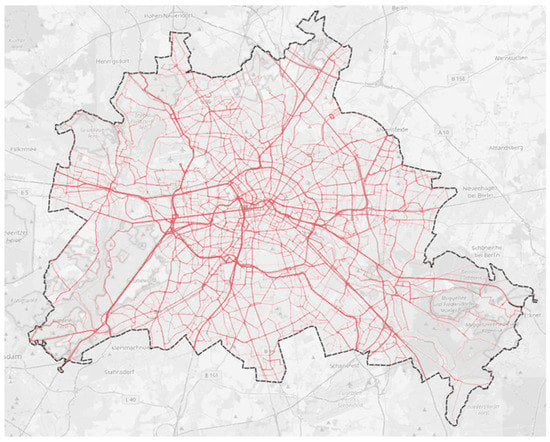
Figure 1.
Study Area.
2.1.2. Carsharing Membership
The CSMembership file contains a list of all the agents authorized to use the carsharing service. As a matter of fact, carsharing is a membership program, which means individuals can become members and therefore use the service only if they meet some specific requirements (e.g., holding a driver’s license, possessing a credit card, etc.). In this study every agent holding a driver’s license is allowed to use the carsharing as an additional mode of transportation (i.e., he is considered to be a member of the service) and, moreover, this mode can be used for a subtour or for the complete trip chain. This means that the membership is stochastically applied to agents that can drive a vehicle.
2.1.3. Configuration
A config file is the connection between the user and MATSim. A list of parameters, belonging to different groups referring to different modules or functionalities of the software, are set up in order to run the simulation. The constants, used to model the scoring function below, are here defined with other parameters, allowing the agents to use different strategies in order to modify their plans.
2.1.4. Plans
A plans file (or population file) consists of a synthetic population mimicking profiles living in the study area, usually generated from census data. In this file the simulator finds the complete agents list with their assigned activity chain. Attributes such as person ID, gender, age, license, car availability, employment status, etc., describe every agent that is part of the simulation. The plans file used in this work is based on the one used in [40] and consists of an 8% sample of the state of Berlin’s population. Every agent is described by its personal activity schedule, with attributes such as activity type, coordinates of the location where the activity takes place, duration of the activity, and mode of transport used to reach a specific facility. Since this population lacks some of the essential attributes described above (i.e., license and car availability), additional information was gathered from another population file described in [41]; here, a 1% sample of the federal state of Berlin and the federal state of Brandenburg’s population is used to export the aforementioned attributes for every agent. This data is univocally linked to a set of GPS coordinates. Having obtained the distribution for every attribute given the district, using a GIS software (QGIS, version 3.14.15), we linked the agents’ GPS coordinates with the districts’ shapefile. That resulted in the assignment of every attribute to a specific agent in the 8% population sample. The same approach was used to link the individual income to every agent using the distribution of the income for every neighborhood [42]. Since the main intention of this paper is to evaluate the users’ behavioral change after the introduction of dynamic pricing, a variable like the value of time (VOT), which is sensible to travel price [28], was needed. Since VOT is directly linked to income and other characteristics of the population heterogeneity, its study, together with the supply utilization, can be used to analyze the fairness of the system.
2.2. Scoring and Value of Time
The score used in MATSim for the evaluation of the agents’ plan considers both the undertaken activities and the performed trips (Equation (1)).
with N the number of activities and q the trip that is induced by the activity. The first term, Sact,q, represents the positive component of the utility (in MATSim this is called scoring) related to executing the set of activities; the second one, Strav,mode(q), represents the disutility of traveling with a given sequence of modes. The second component of this equation is specific to each mode of transport supported by MATSim. The first term has the same form for all the agents and is defined as in Equation (2) [18].
where the five contributions to the scoring consist of: Sdur,q, utility of performing an activity related to its duration; Swait,q, waiting time spent before starting an activity; Slate,ar,q, late arrival penalty; Searly,dp,q, the cost of early arrivals; and Sshort,dur,q, a penalty from a “too short” duration [18].
In this work, an ad hoc distribution of the VOT was applied in order to have better insight into the users’ behavior when facing events that involve a monetary cost. That is, we created a controlled simulation scenario where the population is sharply clustered in VOT-based sectors. In order to determine which effects can be evaluated by changing specific pricing policies, it is important to include a variable sensitive to these variations. Using only the income as sensitive variable would not be sufficient, since it lacks a specific time component. What could make one choose, for example, a mode of transport instead of another is the value of the time saved by making that choice, considering the trip’s purpose and its related utility determinants (scheduling time, duration, location choice). For this reason, the VOT is chosen as sensitive parameter, since it can be assigned ex ante using the marginal value obtained from [43] and directly introduced in the scoring function of MATSim. We therefore introduced the VOT in the utility of performing an activity q as described in the following Equation (3):
where tdur is the performed activity duration, βdur,q is the marginal utility of the activity duration, is the scale factor for the VOT, and t0,q is the duration since the utility starts to be positive. The VOT is fetched directly from the plans file used as input from MATSim. Applying the VOT in the section of the scoring related to the duration of the activity has a specific meaning: if the duration of the activity changes—the change is measured as the difference between the desired duration of the activity (input of the system) and the actual duration (output of the simulation)—it means that the impact on the scoring has a multiplied factor equal to the VOT. At the same time, the fact that an activity is performed leads to an increment of the score that is multiplied by a factor equal to the VOT. This means that higher VOT classes tend to lose more in terms of scoring when the activity does not have the desired duration and gain more when the activity is closer to the desired duration.
Differently from the previous contribution, that used the heterogeneous distribution of eleven classes of VOT [27], only four VOT classes have been selected in this study. The reason behind this choice was to aggregate similar behavior for similar VOT and to keep, at the same time, a similar range (i.e., from 0.13 €/h to 4.83 €/h). Moreover, its spatial distribution is more uniform than in our previous study [16]. This choice helps to understand the overall trends, by removing some degrees of freedom given by the randomness of the VOT distribution. An abundance of users with a specific VOT next to a station could skew the conclusions (that is, too many bookings from that income class), making the results less clear and less interpretable. There are two basic ways to create sectors on a geographic map once the center is given: using a coaxial clustering in order to create a monocentric city or using a radial clustering dividing the entire area in slices. While the coaxial method would follow the logic of a monocentric city where more expensive neighborhoods are located in the center, the radial design increases the contact points of different VOTs and could reveal specific behaviors in stations that are at the border between two VOT regions (e.g., adjacent quarters with different population characteristics and income levels). It should also be observed that the radial combination gives room to more station combinations among different VOT levels, while the coaxial distribution allows for contact only between two contiguous VOT classes. On the one hand, in the radial scenario, we expect stations on the border to be more used than the others, serving only one VOT; on the other hand, in the coaxial configuration, we expect that the longer the distance from the center, the smaller the number of bookings. All the users are represented on the map as a small dot and colored in function of their VOT (Figure 2).
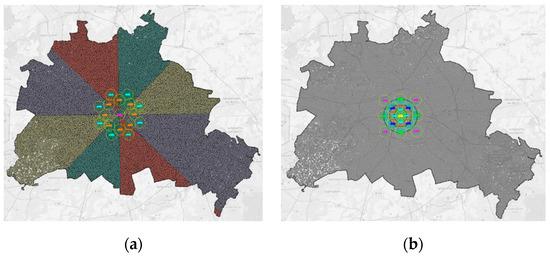
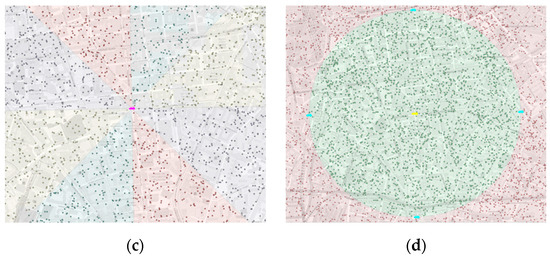
Figure 2.
Distribution of the value of time (VOT) and carsharing stations: (a) radial; (b) coaxial; and their relative close-up: (c) radial; (d) coaxial.
For every station, a yellow dashed circle is drawn. This circle represents the catchment area. This is an area of 800 meters radius; this length is considered the access distance threshold users are generally willing to travel (mainly walking or seldomly using the bike or the public transport) in order to access a carsharing service [44,45]. Anyway, users residing out of the buffer zone could perform a spontaneous booking if a subtour happens in said area.
Concerning the radial distribution, the stations are placed according to three classes, function of the VOT distribution in Table 1. The stations are placed both in the center and on the sectors’ border in order to assess if stations serving one or two VOT classes have specific emerging behaviors.

Table 1.
VOT values and station distributions for radial configuration.
Regarding the coaxial distribution, the stations are placed both at the border between two VOT clusters and immerged in one cluster, as in Table 2. In order to reach the same number of stations as in the radial distribution, four stations were assigned to every sector plus the central one.

Table 2.
VOT values and station distributions for coaxial configuration.
2.3. Dynamic Pricing
Two scenarios assessing different pricing strategies were created. These are: an availability-based pricing scheme, where the trip becomes more expensive as fewer cars are available at a station at the time of booking and a time-dependent pricing scheme, whose pricing value depends on the time of day when a car is booked, independently of car availability.
2.3.1. Availability-Based Dynamic Pricing (ABDP)
This strategy seeks a more uniform distribution of cars and vehicle usage in time and space and is only indirectly dependent on the actual demand. The demand itself, on the other hand, can be sensitive to pricing only if demand elasticity is explicitly considered. This concept is integrated in MATSim by updating the carsharing scoring function (Equation (4)):
The equation is obtained introducing where a is the number of cars available at the station j at the moment of booking and y is the steepness of the pricing curve, αcs(q) is the carsharing-specific constant, βc,cs is the marginal utility of the time spent traveling by carsharing, ct and cd are respectively the marginal monetary cost of time and distance, tr is the total reservation time, d the distance traveled, βt,w the marginal utility of an additional unit of time spent walking, ta and te are respectively the access and egress time, βt,cs represents the marginal utility of an additional unit of time spent traveling with carsharing, and ttrav is the actual (in vehicle) travel time.
In their simplest form, ABDP strategies depend only on the supply available at the moment of booking (i.e., the number of vehicles). These strategies result in three different main price profiles: linear, concave, or convex. When the linear form is used, bookings tend to be strongly underpriced when the supply availability is high [27]. In order to avoid this behavior, and inspired by airline dynamic pricing strategies, this pricing scheme follows a hyperbolic function approach, as already applied in [25]. The final score for traveling will then be affected by a function having a shape like the one drawn in Figure 3, where the shift from a fixed pricing (FP) to an ABDP is also illustrated.
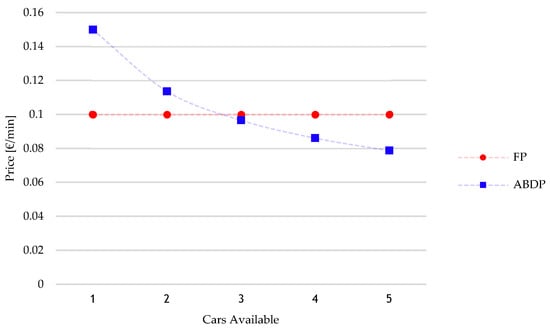
Figure 3.
Hyperbolic form of availability-based dynamic pricing (ABDP) compared to fixed pricing (FP).
Both ABDP and FP amounts are chosen balancing areas below the curve in order, for a hypothetical company, to reach the same revenue when all vehicles in the station are booked. Pricing setup is the following:
- ABDP: 0.15 . price of the last vehicle available at the station
- Fixed pricing = 0.1
The ABDP policy is a demand-responsive strategy. Since the price offered to the client is not fixed a priori, this strategy could be difficult to implement in practice for companies that apply a business model based on planned bookings. On the contrary, it could more easily be employed in case of spontaneous bookings.
2.3.2. Time-Based Dynamic Pricing (TBDP)
The TBDP scenario simulates a pricing scheme dependent on the time of day at which a car is used regardless of the situation at the station where the rental happens. It is designed as in Figure 4.
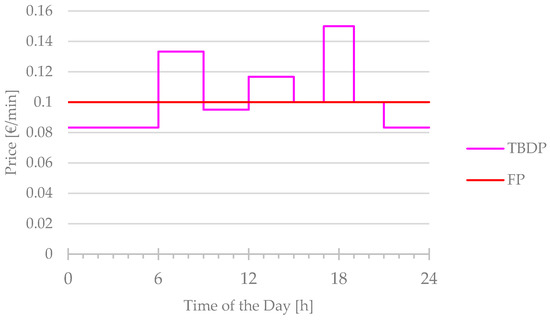
Figure 4.
Price design for time-based dynamic pricing TBDP compared to FP.
The idea behind this strategy is to make cars more expensive during peak hour time, on the one hand, to generate higher revenues for the company during the most demanded times of the day, and, on the other hand, to move the demand away from the peak period. To obtain the pricing curve, a simulation with FP was run, and the carsharing demand was used to design the price profile. The demand profile obtained is consistent with the 2019 revealed traffic data for the city of Berlin [46]. The final curve was achieved setting the area under the purple curve equal to the area underneath the red one.
This policy is a passive strategy. Prices are already known by the system for every booking, and thus it is easier to apply the strategy to companies that prefer planned bookings as their business model. Of course, the TBDP strategy can be implemented without great effort even in business models contemplating spontaneous bookings.
3. Results
The studied region is the Berlin city area, which has been created by importing data from an open street map [47] in QGIS [48], a geographic information system. The area consists of a synthetic population of 280,113 agents, i.e., 8% of the actual population of Berlin [49]. All the agents are members of the carsharing service, and the number of users less than 800 meters away from a station is shown in Table 3.

Table 3.
Users within 800 meters from a station according to VOT.
Only round-trip carsharing is available, with an offer of 85 vehicles divided into 5 vehicles per station for a total of 17 stations for both scenarios. The number of vehicles per station is chosen according to an average fleet size of a round-trip carsharing service in Berlin. All scenarios were run for 600 iterations with a computation time of approximately 30 hours each, running on an HPC [50] with 8 cores (at 2.4 GHz) using 70 GB of RAM. During simulations, each agent was allowed to change his transportation mode, route, and departure time. More information about the code run can be found in Appendix A.
In the following, we report results of the simulation for the radial configuration and the coaxial configuration of the VOT using the scenario definitions as shown in Table 4.

Table 4.
Scenario definition.
3.1. Effects on Carsharing Operations for Radial Configuration (Scenario 1)
Carsharing service providers’ main KPIs can be divided into economic indicators (e.g., revenue) and fleet management indicators (e.g., number of bookings, distance, booking times). The overall KPIs for the radial configuration are reported in Figure 5.
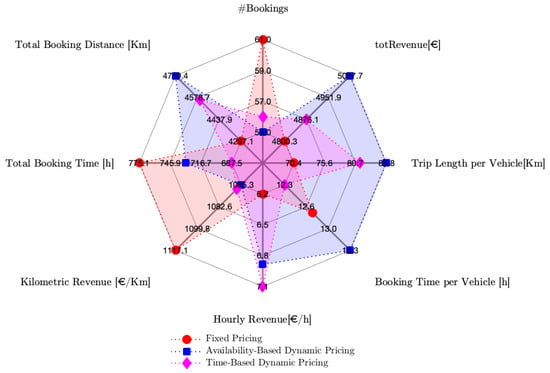
Figure 5.
Provider’s key performance indicators (KPIs).
Each axis reports the value of a specific KPI for the three pricing schemes and ranges between the minimum value (lower limit) and the maximum value (upper limit) amongst the three strategies. For every pricing configuration, the following KPIs are defined:
- #Bookings: total amount of bookings for the whole day
- Tot revenue: sum of all the revenue generated during the single rents
- Trip length per vehicle: average distance traveled
- Booking time per vehicle: average booking time
- Hourly revenue: average revenue generated in one hour of booking
- Kilometric revenue: average revenue generated for every kilometer traveled
- Total booking time: sum of all the booking times
- Total booking distance: sum of all the distance traveled
Once a dynamic pricing strategy is introduced, we observe that the total revenue increases, in particular in the case of an ABDP. Furthermore, it has to be considered that the revenue calculation does not explicitly include accessory costs such as maintenance costs and cleaning efforts, that account for one third of carsharing service costs [51]. However, these are directly linked to the number of kilometers traveled and usage rates of a car. For this reason, it is important to take into account the life expectancy of a carsharing car and note that the ABDP strategy leads to a higher total booking distance if compared to the FP strategy.
A TBDP encourages people to book for shorter times. This can lead to a loss of revenues because cars are sitting unused on the road for most of the time.
Even though the fixed pricing leads to higher total booking times, it does not bring an increase of revenue to the company. It actually becomes a negative factor, since the company gives away resources for a lower price (low hourly revenue).
The number of bookings can be further analyzed in terms of number of bookings per station, in order to optimize operations, as shown in Figure 6. The color code here follows the one illustrated in Figure 2a and described in Table 1 for the station distribution.

Figure 6.
Number of bookings per station. (a) FP strategy; (b) ABDP strategy; (c) TBDP strategy.
The ABDP tends to homogenize the station’s utilization, reducing the range between the most used and underused stations (from four vehicles to three). The TBDP has the opposite effect and tends to concentrate the activity on a limited number of stations; here the range passes from four vehicles in the FP to a deviation of six vehicles. There are more underused stations when dynamic pricing is applied.
3.2. Effects on Demand for Radial Configuration (Scenario 1)
On the demand pattern side, indicators are different compared to the ones previously described and focus on the modes chosen, activities done, and score.
People using carsharing in the FP scenario are not necessarily going to use the service again when the dynamic pricing strategy is applied. To assess their choices, we monitored the behavior of this group of people after the introduction of dynamic pricing. To do that, we call:
- FP-ABDP to the indicators retrieved in the ABDP simulation for the users that took the carsharing when a FP strategy was in place; and
- FP-TBDP to the indicators retrieved in the TBDP simulation for the users that took the carsharing when a FP strategy was in place.
Figure 7 shows the score distribution over carsharing users for the three different scenarios, as well as for these two additional groups. We observe that changing the strategy from fixed to dynamic pricing leads to a higher mean of the score distribution for agents using carsharing. FP brings a higher variance but most of it is on the negative side of the graph. Overall, agents abandoning the carsharing service in TBDP increase their score, while the same does not happen in ABDP.
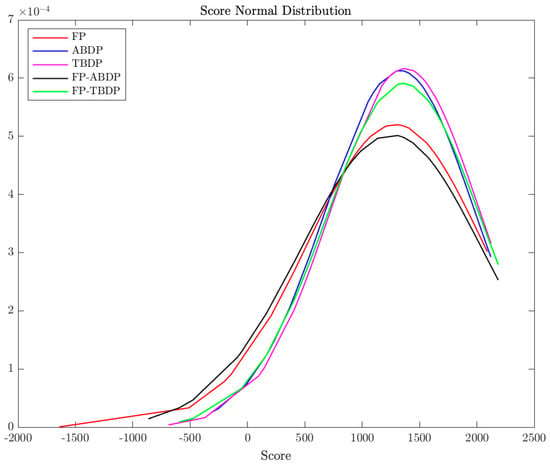
Figure 7.
Normal distribution of the score.
To have a better assessment of what happens to every VOT class in terms of average score, we refer to Figure 8. The number of VOT agents refers to the amount of people of a certain VOT who have access to the service (i.e., who live within a 800 m radius from a station). On Figure 8a, we can see that the score grows according to the increasing VOT, meaning that high VOT classes obtain a greater utility when using carsharing. At the same time, when the ABDP is applied, the most affected class is the lowest VOT one. The same method applied to the number of bookings (Figure 8b) shows, on the one hand, a stronger loss for low VOT agents who book less if compared to the FP scenario. On the other hand, high VOT groups tend to execute more bookings.
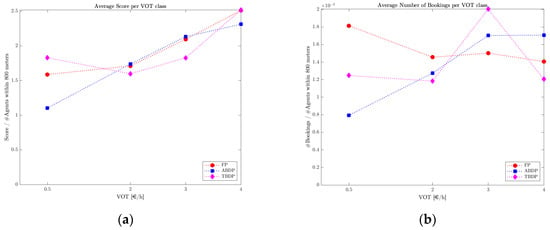
Figure 8.
Average (a) score; (b) bookings per VOT class.
It is possible to notice that for the highest VOT in the TBDP scenario we do not have the same behavior as in the ABDP. There are two reasons why this can happen: one endogenous and one behavioral. First of all, as we stated before in Section 2.2, the VOT is introduced in the scoring function related to the duration of the activity, and it multiplies βdur,q, the marginal utility of activity duration. For activities related to work, this marginal utility is the highest; however, at the same time, the working hours are when the price is the highest. This combination impacts more people with high value of time. Secondly, we have to consider that people with high value of time—which in this study comes from the income—are people that can usually take advantage of a large number of modes. This results in their ability to switch to more convenient modes if carsharing is not convenient (i.e., they receive a low score using it) and keep using carsharing if it is convenient anyway. This explanation is illustrated by Figure 8a, in which it is shown that, even though there are fewer bookings, the score is the highest among all the scenarios and VOT classes.
In order to better understand these dynamics, related to different pricing scenarios, we assessed the impact of the dynamic pricing on both aspects of the score: mode and activity choice.
Figure 9a shows two different trends: modes that are used in combination with carsharing (red, blue, and magenta) and the modes with which former carsharing users replace the service when dynamic pricing is applied (black and green). Even though customers opt for all kinds of modes, it is the car that mainly replaces carsharing, as its numbers are higher than for other modes. Those who choose carsharing opt for the service for the most part of their daily trip chain.
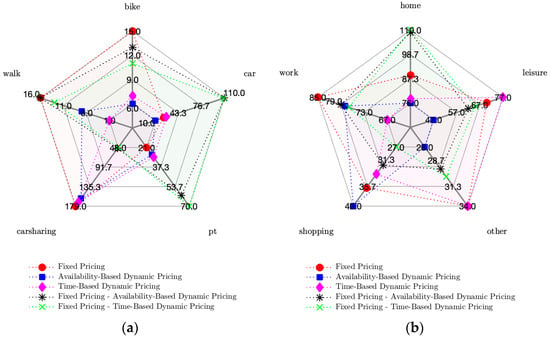
Figure 9.
Distribution of (a) modes; (b) activities.
Figure 9b shows the activities performed during the day. When FP is applied, car-sharing agents’ main activity is working, while for the ABDP and the TBDP the service respectively attracts users who travel for shopping and leisure. Finally, users that have more home activities during the day (i.e., they go back home more often before proceeding to the next activity) are the users who used carsharing only when the FP strategy was active.
To show that the user groups have a different behavior if a dynamic pricing strategy is applied, we show (Figure 10) the difference in percentage of the booking profile when dynamic pricing strategies were offered against the fixed pricing strategy. When the line is above zero the number of bookings happening at a precise time is higher in the dynamic pricing than the fixed price scenario, and, vice-versa, if the line goes under zero, the FP strategy scenario shows more bookings.
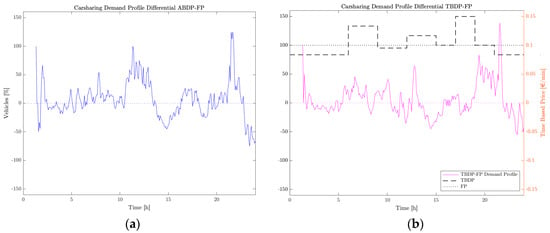
Figure 10.
Carsharing demand profile for (a) FP and ABDP; (b) FP and TBDP.
In Figure 10a, we see how the morning peak is not much affected by the dynamic pricing. This is due to the fact that the penalty in arriving late at work is higher than for other activities. The typical effect of this kind of pricing can be seen during the late morning, since a peak is followed by a loss in bookings. This effect is due to the price increment linked to the reservations made in the previous hours. The same behavior can be seen in the afternoon and in the evening.
In Figure 10b, we can see the same behavior in the early morning, while in the afternoon peaks tend to follow the pricing scheme with some delay. In the first part of the morning (from 6:00 to 7:00) the high price does not lower the demand; the reason is similar to the one given in the previous paragraph for the ABDP strategy: the utility generated at work is higher than the one generated in other activities. Around 8:30, the price weights more, but from 9:00 the lower price increases the number of bookings. In the afternoon and in the evening the booking behavior follows more the dynamic pricing strategy, except for the late-night period, where it is not possible, given the pricing strategy, to attract more demand.
3.3. Effects on Carsharing Operations for Coaxial Configuration (Scenario 2)
The subdivision of the companies’ main KPIs is the same as in the previous paragraph: economic indicators (e.g., revenue) and fleet (e.g., number of bookings, distance, booking times). The overall KPIs for the coaxial configuration are reported in Figure 11.
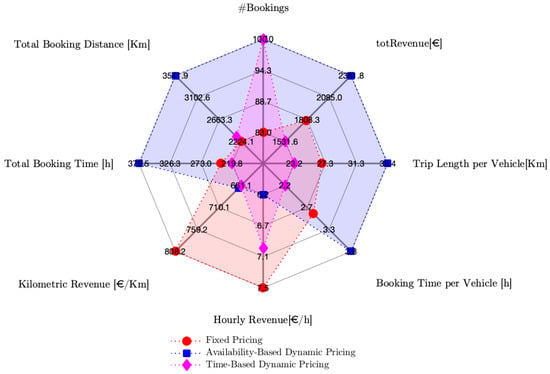
Figure 11.
Provider’s KPIs.
The KPIs tend to be similar to the ones reported in the radial configuration, meaning that service providers’ indicators do not significantly vary in function of the distribution of the purchase power in the city. With this configuration, the TBDP strategy collects the highest amount of booking, but the ABDP is still the one that guarantees the highest revenue to the operator among the three schemes. As for the previous case, it has to be considered that the revenue calculation does not include accessory costs such as maintenance costs, as these are directly linked to the number of kilometers traveled and usage rates of a car. For this reason, it is important to take into account the life expectancy of a carsharing car and note that the ABDP strategy leads to a higher total booking distance if compared to the FP or ABDP strategy. That is, taking into account the life cycle, part of the advantage could be eroded by the need to change cars more often.
Even in this occasion, the TBDP encourages people to book for shorter times. This can lead to a loss of revenue because cars are left unused on the road for most of the time.
The number of bookings can be further analyzed in number of bookings per station, in order to optimize operations, as shown in Figure 12. The color code here follows the one illustrated in Figure 3 and described in Table 2 for the station distribution.

Figure 12.
Number of bookings per station (a) FP strategy; (b) ABDP strategy; (c) TBDP strategy.
Here, the ABDP tends to not homogenize the station’s use even though it reduces the range between the most used and underused stations. The TBDP tends to concentrate the activity on a limited number of stations, resulting in high amounts of underused stations, similarly to what happens in Figure 12a.
3.4. Effects on Demand for Coaxial Configuration (Scenario 2)
On the demand side, the indicators focus again on modes, activities, and score.
In this scenario, we found the same behavior from carsharing users as in the previous configuration. Agents using carsharing in the FP scenario are not necessarily going to use the service when the dynamic pricing strategy is applied; that is why we monitored the behavior of this group of people after the introduction of the dynamic pricing (FP-ABDP for the introduction of the ABDP strategy and FP-TBDP for the introduction of the TBDP strategy).
In Figure 13 we show the distribution of the score over carsharing users for the three different scenarios as well as these two additional groups.
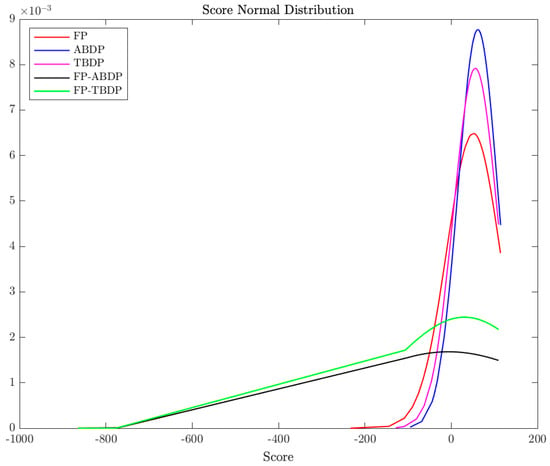
Figure 13.
Normal distribution of the score.
Even on this occasion, switching to a dynamic pricing strategy leads to a higher average score for agents using carsharing.
To have a better assessment of what happens to every VOT class in terms of average score, we refer to Figure 14.
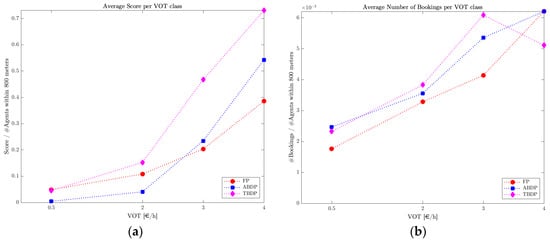
Figure 14.
Ratio on number of agents per VOT for (a) score; (b) bookings.
On Figure 14a we can see that the score grows together with the VOT, meaning that high VOT classes have greater utility using carsharing. The ABDP strategy affects lower VOT groups negatively, making them gain a lower utility if compared to other scenarios. In this configuration, once the TBDP strategy is applied, lower VOT groups achieve a better score than when the FP strategy is active. The same method applied to the number of bookings (Figure 14b) shows that it is possible to obtain more bookings when a dynamic pricing strategy is applied. However, the groups with high VOT are the ones who systematically gain the most with this policy. In Figure 14b we can notice a similar trend as in Figure 8b. The reason is similar to the one given above, in Section 3.2, with the addition that, for the coaxial configuration, people with high VOT live in the city center, where the public transportation offer is stronger. This results in a higher score in Figure 14a than the one obtained in Figure 8a, since the agents that use carsharing are the ones that strongly benefit from it.
In order to better understand these dynamics between different pricing scenarios, in Figure 15 we assessed the impact of the dynamic pricing on both aspects of the score: mode and activity choice.

Figure 15.
Distribution of (a) modes; (b) activities.
Figure 15a shows two different trends: the modes that are used in combination with carsharing and those with which former carsharing users replace the service once dynamic pricing is applied. Customers tend to opt for all modes, but the car is the main replacement for carsharing when we switch from an FP to an ABDP strategy, and public transport is the main replacement for carsharing when we switch from an FP to a TBDP strategy. Those who choose carsharing in the dynamic strategy opt for the service for most of their daily trip chain. Figure 15b shows the activities performed during the day. When FP is applied, agents’ main activity is shopping, while for the ABDP and the TBDP, the service respectively attracts users who travel for work and leisure (the former) or shopping and other activities (the latter). Finally, users that have more home activities during the day (i.e., who go back home more often before proceeding to the next activity) are the users who used carsharing only when the FP strategy was active.
To show that the user group has different a behavior if a dynamic pricing strategy is applied, we show (Figure 16) the difference in percentage of the booking profile when dynamic pricing strategies were offered against the fixed pricing strategy.
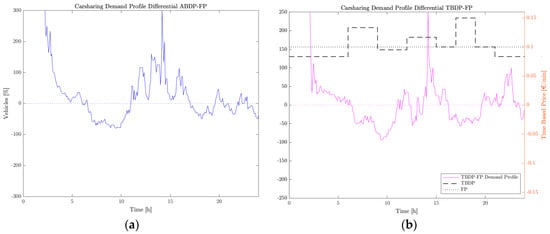
Figure 16.
Carsharing demand profile for (a) FP and ABDP; (b) FP and TBDP.
In Figure 16a, we see how the morning peak is affected by the dynamic pricing. People have lower fares early in the morning, and this leads to a lower amount of departures once the morning peak is over. For the same reason, lower peaks alternate with higher peaks, since users that can wait for cars to be returned back at the station take advantage of better prices. Figure 16a is more “extreme” when compared to Figure 10a. The increase after 10:00 and the following decrease (this time after 15:00) is similar to the one experienced in the radial scenario. In Figure 16b, we can see the same behavior in the morning, this time justified by a lower price, and even in the evening, as peaks tend to follow the pricing scheme.
4. Discussion
The observed data shows an impact of dynamic pricing on carsharing users’ behavior. Once the dynamic pricing strategies are applied, people with a low VOT will see the utility of using carsharing decrease. The implemented policy, as it is, does not appear to guarantee equity, since it does not have the same impact for all population classes. Either way, both strategies have different impacts whether carried out in cities with a more radial configuration or with a coaxial distribution of the purchase power.
Concerning the radial scenario, we obtained a light homogenization in terms of bookings per station. This could be beneficial for companies looking for a better distribution of their fleet, and results could be improved with a different configuration, with closer stations (i.e., increasing the number of stations the agents can access by walking for distances lower than 1600 meters). Overall, the average score is higher for both strategies but, as different agents start to use the service, the utility is distributed differently, benefitting people with an average and average-to-high VOT, in case of an ABDP strategy. This is because the policy, as it is conceived, favors users that are able to spend more when the vehicles’ price rises. Trends for the TBDP have a specular movement that follows the FP strategy. Moreover, the TBDP can achieve a better daily spatial distribution of the demand concerning the afternoon peak. Morning trends are similar, since most of the activities executed in the morning are about work, an activity with high penalties for late arrival—penalties that are stronger than the benefits that a change of departure time can produce. On a future perspective, if the carsharing trend continues to grow, such a strategy can be attractive to public regulators, since it leads to specific benefits in actively reducing or increasing carsharing flows in specific times of the day. The morning behavior is similar even in the ABDP strategy. The morning demand profile is not strongly affected by the policy, while the afternoon period leads to a homogenization of the profile: the lower peak rises, and the high peak is more contained. While even this strategy can attract regulators, because of its inherent ability to smooth the demand peaks, it is harder to manage, since the demand profile is a function of the price that is itself modified by the demand elasticity. On the supply side, the ABDP strategy is the one that increases the revenue the most. At the same time, it reduces the amount of booking, allowing for a smaller fleet that, considering the trip length and booking time per vehicle—that is higher if compared to the other strategies—leads to a faster wear of the vehicles. This has to be taken into account for further analyses on longer time frames where maintenance costs are considered, to check if the increment in revenue brings an increase in profits.
Regarding the coaxial distribution, the difference between stations with the highest and the lowest number of daily bookings is reduced. This could be beneficial for companies, even though further analyses with closer stations should be done to prove its effectiveness. The average score is higher when a dynamic pricing strategy is applied, favoring agents who live in the city center. The ABDP strategy brings a loss of utility to the lower VOT classes while enhancing the score for the users with a stronger purchase power. This is because this kind of customers are less affected by the higher prices and are able to book a vehicle at any time of the day without being affected by the strategy. Overall, both strategies attract more bookings, independently of the income class, resulting in higher rental numbers. This is linked to the great benefits in score that these strategies create if applied to coaxial configuration. In this scenario, generally, we see the same benefits in terms of demand profile. Even the morning peek is affected by the introduction of these two strategies, because, considering that different users use the service, in the ABDP strategy more people find carsharing convenient to go to work, and in the TBDP strategy the lower price attracts people that need the car at that time. On the supply side, both strategies are able to increase the number of bookings, while only the ABDP brings a higher revenue for the company. The TBDP is more attractive only when the carsharing price is lower and does not level off the lower price with the number of bookings made when the service costs more. Although it reduces the kilometers traveled, lowering the cars’ usage, it cannot produce higher revenues per vehicle booked.
5. Conclusions
In this paper we have conducted an explorative analysis of how availability-based and time-based dynamic pricing schemes impact demand and supply performances. When dynamic pricing is applied, people with low value of time tend to abandon the carsharing mode in favor of other modes of transportation. Depending on the pricing strategy offered, a carsharing company is able to raise its revenue or the number of cars booked per day. As was shown, dynamic pricing strategies can be forged to increase operators’ revenue but, at the same time, it is not known yet if this can automatically generate higher profits. For example, a cost-benefit analysis could help carsharing companies to better understand the possible implications of choosing this kind of dynamic strategies.
Both pricing strategies here simulated appear to have different impacts for people belonging to different VOT classes, except for the TBDP with radial VOT distribution. This means that, in case a company should switch to a dynamic pricing strategy, a major involvement with a public and private partnership should be foreseen in order to control and mitigate the negative impacts such policy could have on the population. While end-users can take advantage of lower prices depending on the time of day or the state of the supply in the station where they pick up a vehicle, these same benefits can be distributed unequally. This distribution can be linked to the daily activity plans and to the income of the user. The user base used in this study is completely stochastic, and it is not based on an existing carsharing population. This means that considerations about equity can only be taken as a general conclusion. Further research could use a thoroughly defined member base and more realistic fleet in order to produce better insights on real case scenarios.
The ABDP strategy brings more benefits to companies in both scenarios, leading to an increase in revenue, while the TBDP strategy is beneficial when compared to an FP policy, if the income distribution resembles more the radial one. On the one hand, the ABDP’s main limitation is its demand-responsive nature, since an instantaneous change in demand leads to an instantaneous change of the price which, as shown, results in a revenue increment. On the other hand, these strategies are hard to control for carsharing operators, making the fleet management difficult and introducing issues regarding planned bookings. TBDP strategies, as implemented here, are not demand-responsive and can be used to plan the pricing offers in advance.
The approach described in this work helped reduce the complexity of the problem and to understand the inner workings of these strategies. It would be preferable, in any case, to switch back to an individual VOT in order to assess more realistic scenarios, making use of the outcome of this work.
The kind of approach used in this paper to simulate dynamic pricing in carsharing can be adapted to other streams of research, for example to the trend of upcoming connected and autonomous vehicles. Considering this new mode, the study we proposed could be extended to all the agents who do not have a driver’s license. The extension could even be done with MATSim, since an autonomous vehicle contribution has already been implemented.
Further research will focus on building a hybrid pricing (HP) policy that could mix the benefits of the two strategies here analyzed, reducing, at the same time, the disadvantages. An HP strategy based initially on the ABDP policy could lead to a desired demand profile that could be implemented through a TBDP strategy in order to be, at the same time, demand- and time-responsive, allowing for planned booking and increasing the revenue toward values that a sole TBDP price cannot achieve.
Author Contributions
Conceptualization, G.G., F.C., F.V.; methodology, G.G., F.C., F.V.; software, G.G.; formal analysis, G.G.; data curation, G.G.; writing—original draft preparation, G.G.; writing—review and editing, G.G., F.C., F.V.; visualization, G.G., F.C., F.V.; supervision, F.C., F.V.; project administration, F.V.; funding acquisition, G.G., F.V. All authors have read and agreed to the published version of the manuscript.
Funding
The present project, STREAMS (ref. 11608347), is supported by the National Research Fund, Luxembourg.
Acknowledgments
The authors would like to thank Luca Bolzani, Oply, for his help on the computational work on Java.
Conflicts of Interest
The authors declare no conflict of interest.
Appendix A
The version of MATSim employed to execute this experiment can be found at the following address: https://github.com/ggiorgione/streams, while the data used can be found at this address: https://github.com/ggiorgione/DynamicPricing.
References
- Shaheen, S.; Sperling, D.; Wagner, C. A short history of carsharing in the 90′s. J. World Transp. Policy Pract. 1999, 5, 24. [Google Scholar]
- Cici, B.; Markopoulou, A.; Frias-Martinez, E.; Laoutaris, N. Assessing the potential of ride-sharing using mobile and social data: A tale of four cities. In Proceedings of the UbiComp 2014—ACM International Joint Conference on Pervasive and Ubiquitous Computing, Seattle, WA, USA, 13–17 September 2014; pp. 201–211. [Google Scholar]
- Schuster, T.D.; Byrne, J.; Corbett, J.; Schreuder, Y. Assessing the potential extent of carsharing a new method and its implications. Transp. Res. Rec. 2005, 1927, 174–181. [Google Scholar] [CrossRef]
- Burns, L.D. A vision of our transport future. Nature 2013, 497, 181–182. [Google Scholar] [CrossRef] [PubMed]
- Nijland, H.; van Meerkerk, J. Mobility and environmental impacts of car sharing in the Netherlands. Environ. Innov. Soc. Transit. 2017, 23, 84–91. [Google Scholar] [CrossRef]
- Martin, E.W.; Shaheen, S.A. Greenhouse gas emission impacts of carsharing in north America. IEEE Trans. Intell. Transp. Syst. 2011, 12, 1074–1086. [Google Scholar] [CrossRef]
- Shaheen, S. Shared mobility policy briefs: Definitions, impacts, and recommendations. Transp. Sustain. Res. Center 2018. [Google Scholar] [CrossRef]
- Degirmenci, K.; Breitner, M.H. Carsharing: A literature review and a perspective for information systems research. In Proceedings of the Tagungsband Multikonferenz Wirtschaftsinformatik, Paderborn, Germany, 26–28 February 2014; pp. 962–979. [Google Scholar]
- Perboli, G.; Ferrero, F.; Musso, S.; Vesco, A. Business models and tariff simulation in car-sharing services. Transp. Res. Part Policy Pract. 2018, 115, 32–48. [Google Scholar] [CrossRef]
- Di Febbraro, A.; Sacco, N.; Saeednia, M. One-way carsharing: Solving the relocation problem. Transp. Res. Rec. J. Transp. Res. Board 2012, 2319, 113–120. [Google Scholar] [CrossRef]
- Pfrommer, J.; Warrington, J.; Schildbach, G.; Morari, M. Dynamic vehicle redistribution and online price incentives in shared mobility systems. IEEE Trans. Intell. Transp. Syst. 2014, 15, 1567–1578. [Google Scholar] [CrossRef]
- Zhou, S. Dynamic Incentive Scheme for Rental Vehicle Fleet Management. Master’s Thesis, Massachusetts Intitute of Technology, Cambridge, MA, USA, 2012. [Google Scholar]
- Jorge, D.; Molnar, G.; de Almeida Correia, G.H. Trip pricing of one-way station-based carsharing networks with zone and time of day price variations. Transp. Res. Part B Methodol. 2015, 81, 461–482. [Google Scholar] [CrossRef]
- Brendel, A.B.; Zapadka, P.; Brennecke, J.T.; Kolbe, L.M. A decision support system for computation of carsharing pricing areas and its influence on vehicle distribution. In Proceedings of the ICIS 2017: Transforming Society with Digital Innovation, Seoul, Korea, 10–13 December 2017. [Google Scholar]
- Ciari, F.; Balac, M.; Balmer, M. Modelling the effect of different pricing schemes on free-floating carsharing travel demand: A test case for Zurich, Switzerland. Transportation 2015, 42, 413–433. [Google Scholar] [CrossRef]
- Harms, S.; Truffe, B. The Emergence of a Nation-Wide Carsharing Co-Operative in Switzerland; EAWAG: Zürich, Switzerland, 1998. [Google Scholar]
- Rieser, M. Researching the influence of time-dependent tolls with a multi-agent traffic simulation. In Proceedings of the European Transport Conference, Leiden, The Netherlands, 17–19 October 2007. [Google Scholar]
- Horni, A.; Nagel, K.; Axhausen, K.W. The Multi-Agent Transport Simulation MATSim; Ubiquity Press: London, UK, 2016. [Google Scholar]
- Horni, A.; Axhausen, K.W. Distribution of benefits and losses from roadpricing illustrated in a microsimulation scenario. Arb. Verk. Und Raumplan. 2014, 31, 974. [Google Scholar]
- de Freitas, L.M.; Schuemperlin, O.; Balać, M. Road pricing: An analysis of equity effects with MATSim. In Proceedings of the 16th Swiss Transport Research Conference, Ascona, Switzerland, 18–20 May 2016. [Google Scholar]
- Balac, M.; Ciari, F.; Axhausen, K.W. Modeling the impact of parking price policy on free-floating carsharing: Case study for Zurich, Switzerland. Transp. Res. Part C Emerg. Technol. 2017, 77, 207–225. [Google Scholar] [CrossRef]
- Kamatani, T.; Nakata, Y.; Arai, S. Dynamic pricing method to maximize utilization of one-way car sharing service. In Proceedings of the 2019 IEEE International Conference on Agents (ICA), Jinan, China, 18–21 October 2019; pp. 65–68. [Google Scholar]
- Zhang, J.; Meng, M.; Wang, D.Z.W. A dynamic pricing scheme with negative prices in dockless bike sharing systems. Transp. Res. Part B Methodol. 2019, 127, 201–224. [Google Scholar] [CrossRef]
- McAfee, R.P. Dynamic pricing in the airline industry. In Handbook on Economics and Information Systems; Elsevier: Amsterdam, The Netherlands, 2006; Volume 44. [Google Scholar]
- Williams, K.R. Dynamic airline pricing and seat availability. SSRN Electron. J. 2017, 2103. [Google Scholar] [CrossRef][Green Version]
- Gibbs, C.; Guttentag, D.; Gretzel, U.; Yao, L.; Morton, J. Use of dynamic pricing strategies by Airbnb hosts. Int. J. Contemp. Hosp. Manag. 2018, 30, 2–20. [Google Scholar] [CrossRef]
- Giorgione, G.; Ciari, F.; Viti, F. Availability-based dynamic pricing on a round-trip carsharing service: An explorative analysis using agent-based simulation. Procedia Comput. Sci. 2019, 151, 248–255. [Google Scholar] [CrossRef]
- Du Plessis, W.; Joubert, J.W. Evaluating the effect of road pricing strategies in matsim, using agent-specific and income-dependent values. In Proceedings of the International Conference on Computers and Industrial Engineering, CIE 2012, Cape Town, South Africa, 16 July 2012; Volume 1, pp. 525–532. [Google Scholar]
- Cascetta, E. Transportation Systems Analysis: Models and Applications; Springer: Berlin/Heidelberg, Germany, 2009. [Google Scholar]
- Ciari, F.; Bock, B.; Balmer, M. Modeling station-based and free-floating carsharing demand: Test case study for Berlin. Transp. Res. Rec. 2014, 2416, 37–47. [Google Scholar] [CrossRef]
- Ciari, F.; Balmer, M.; Axhausen, K.W. Concepts for a Large Scale Car-Sharing System: Modeling and Evaluation with an Agent-Based Approach; Eidgenössische Technische Hochschule, Institut für Verkehrsplanung und Transportsysteme: Zurich, Switzerland, 2008. [Google Scholar]
- Lopes, M.M.; Martinez, L.M.; Correia, G.H.D.A. Simulating carsharing operations through agent-based modelling: An application to the city of Lisbon, Portugal. Transp. Res. Procedia 2014, 3, 828–837. [Google Scholar] [CrossRef]
- Laarabi, H.M.; Boldrini, C.; Bruno, R.; Porter, H.; Davidson, P. On the performance of a one-way car sharing system in suburban areas: A real-world use case. In Proceedings of the VEHITS 2017—3rd International Conference on Vehicle Technology and Intelligent Transport Systems, Porto, Portugal, 22 April 2017; pp. 102–110. [Google Scholar]
- Lu, Y.; Basak, K.; Carrion, C.; Loganathan, H.; Adnan, M.; Pereira, F.C.; Saber, V.H.; Ben-Akiva, M. SimMobility mid-term simulator: A state of the art integrated agent based demand and supply model. In Proceedings of the 94th Annual Meeting of the Transportation Research Board, Washington, DC, USA, 11–15 January 2015. [Google Scholar]
- PTV Group. PTV Evaluate Business Models for the Future of Mobility. Available online: //www.ptvgroup.com/en/mobilitynext/ (accessed on 8 January 2019).
- Burghout, W.; Koutsopoulos, H.N. Hybrid traffic simulation models: Vehicle loading at Meso-Micro Boundaries. In Transport Simulation; Chung, E., Dumont, A.-G., Eds.; EPFL Press: Lausanne, Switzerland, 2019; pp. 27–41. ISBN 978-0-429-09325-8. [Google Scholar]
- Wilensky, U.; Rand, W. An Introduction to Agent-Based Modeling: Modeling Natural, Social, and Engineered Complex Systems with NetLogo; MIT Press: Cambridge, MA, USA, 2015. [Google Scholar]
- Gatta, V.; Marcucci, E.; Pira, M.L.; Inturri, G.; Ignaccolo, M.; Pluchino, A. E-groceries and urban freight: Investigating purchasing habits, peer influence and behaviour change via a discrete choice/agent-based modelling approach. Transp. Res. Procedia 2020, 46, 133–140. [Google Scholar] [CrossRef]
- Nico Kühnel Network Editor for JOSM. Manual. Available online: https://josm.openstreetmap.de (accessed on 21 May 2020).
- Ziemke, D.; Nagel, K. Development of a Fully Synthetic and Open Scenario for Agent-Based Transport Simulations—The MATSim Open Berlin Scenario. Available online: https://svn.vsp.tu-berlin.de/repos/public-svn/publications/vspwp/2017/17-12/ZiemkeNagel2017BerlinScenario.pdf (accessed on 1 August 2019).
- Rieser, M.; Nagel, K.; Beuck, U.; Balmer, M.; Rümenapp, J. Agent-oriented coupling of activity-based demand generation with multiagent traffic simulation. Transp. Res. Rec. 2007, 2021, 10–17. [Google Scholar] [CrossRef]
- Amt für Statistik Berlin-Brandenburg. Available online: https://www.statistik-berlin-brandenburg.de/ (accessed on 1 August 2019).
- Axhausen, K.W.; Ehreke, I.; Glemser, A.; Hess, S.; Jödden, C.; Nagel, K. Schlussbericht: FE-Projekt-Nr. 96.996/2011; ETH: Zurich, Switzerland, 2015; p. 308. [Google Scholar]
- Ciari, F.; Schuessler, N.; Axhausen, K.W. Estimation of carsharing demand using an activity-based microsimulation approach: Model discussion and some results. Int. J. Sustain. Transp. 2013, 7, 70–84. [Google Scholar] [CrossRef]
- Martínez, L.M.; de Correia, G.H.A.; Moura, F.; Lopes, M.M. Insights into carsharing demand dynamics: Outputs of an agent-based model application to Lisbon, Portugal. Int. J. Sustain. Transp. 2017, 11, 148–159. [Google Scholar] [CrossRef]
- Berlin Traffic Report. TomTom Traffic Index. Available online: https://www.tomtom.com/en_gb/traffic-index/berlin-traffic/ (accessed on 4 August 2020).
- Geofabrik Berlin OSM. Available online: http://download.geofabrik.de/europe/germany/berlin.html (accessed on 21 May 2020).
- Welcome to the QGIS Project! Available online: https://www.qgis.org/en/site/ (accessed on 21 May 2020).
- Einwohnerinnen und Einwohner im Land Berlin am 31. December 2019. Available online: https://www.statistik-berlin-brandenburg.de/publikationen/stat_berichte/2020/SB_A01-05-00_2019h02_BE.pdf (accessed on 21 May 2020).
- Varrette, S.; Bouvry, P.; Cartiaux, H.; Georgatos, F. Management of an academic HPC cluster: The UL experience. In Proceedings of the 2014 International Conference on High Performance Computing & Simulation (HPCS), Bologna, Italy, 21–25 July 2014; IEEE: Bologna, Italy, 2014; pp. 959–967. [Google Scholar]
- Bösch, P.M.; Becker, F.; Becker, H.; Axhausen, K.W. Cost-based analysis of autonomous mobility services. Transp. Policy 2018, 64, 76–91. [Google Scholar] [CrossRef]
© 2020 by the authors. Licensee MDPI, Basel, Switzerland. This article is an open access article distributed under the terms and conditions of the Creative Commons Attribution (CC BY) license (http://creativecommons.org/licenses/by/4.0/).




